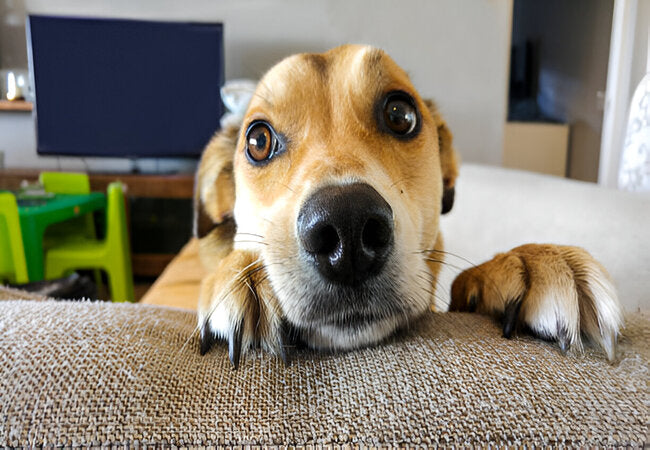2025 Vet Insight: Why Does My Dog Keep Staring at Me? 🐶👀

In this article
2025 Vet Insight: Why Does My Dog Keep Staring at Me? 🐶👀
By Dr. Duncan Houston BVSc
Hi, I’m Dr Duncan Houston BVSc, veterinarian and founder of Ask A Vet. If your pup locks eyes on you often, it’s more than just puppy love—it’s communication. Dogs use eye contact for bonding, asking, reading cues, seeking reassurance, and even warning. Let's explore these motivations and how to respond in ways that strengthen your relationship.
1. Love & Affection ❤️
Mutual gazing between you and your dog increases oxytocin, the “bonding hormone.” Studies show that dogs and their owners experience emotional closeness and stress reduction through eye contact.
If your dog stares softly, tail loose, with relaxed posture, they’re likely expressing affection and connection.
2. Requesting Something 🦴
Dogs quickly learn that staring earns rewards—food, walks, attention—through “cause and effect.” If they stare at you at mealtimes or before walk time, they’re likely making a polite ask. Want to avoid begging? Train them to use a cue (e.g. "kiss" or mat) before giving treats or meals.
3. Observing for Cues & Learning 🧠
Your pup watches your body and face to decode meaning. If they stare during a command and wait for your next move, they’re tuning in to your guidance. This focus means they’re engaged—use that to support training with a “look at me” cue and positive reinforcement.
4. Seeking Reassurance or Protection 🛡️
During vulnerable moments—like defecating or in unfamiliar settings—dogs may stare at you to check if it’s safe. They rely on your presence for reassurance. Respond with calm support—soft tone, gentle praise—to build confidence.
5. Confusion or Uncertainty 🤔
If your pup stares blankly during training or doesn’t understand you, they’re trying to comprehend what you want. Clarify: simplify cues, show correct behavior, and reward small steps to aid learning.
6. Anxiety or Stress 🧘
A hard stare—especially with stiff body, pinned ears, or dilated pupils—can indicate anxiety or agitation. In these moments, offering space, gentle reassurance, or calming tools like pheromones through Purrz can help ease stress.
7. Attention-Seeking 🗣️
Starting to get noticed can escalate into whining or pawing. While it’s less disruptive than barking, it still interferes with calm focus. Teach “sit and watch me” and reward focused, quiet attention. Engage them with mental games and interactive toys from Woopf.
8. Warning or Aggression ⚠️
A fixed, silent stare with stiff posture could signal dominance, resource guarding, or aggression. Signs include raised hackles, low growl, and hard eyes. In this case, don’t stare back. Give space and consult a vet behaviorist via the Ask A Vet app.
9. Cognitive or Medical Issues 🧬
Older dogs that stare off into space may be showing early canine cognitive dysfunction (dementia). Signs include disorientation and house-soiling—vet assessment is recommended.
10. How to Respond Appropriately
- Relaxed stare: Gently return gaze or offer calm praise.
- Staring during mealtime/play: Teach “go to mat” or “look” so it becomes polite asking.
- Focused stare in training: Use “watch me” cue + treat to reinforce attention.
- Stress stare: Pause session, create a safe space, use calming tools.
- Hard stare with tension: Back off, avoid direct eye contact; consult a professional.
11. Training Exercises to Encourage Healthy Eye Contact
- Hold a treat near your eyes—mark gaze with “yes,” treat reward.
- Extend gaze time before reward—build duration slowly.
- Add slight movement—gaze remains focused under distractions.
- Gradually fade the treat, reward with praise or petting.
12. FAQs ❓
- Q: My dog stares during meals—is that normal?
- A: Yes—they’re asking for food. Teach polite cues and reward calm patience instead of begging.
- Q: Is any staring bad?
- A: No—context matters. Relaxed gazing often strengthens bonding, but a stiff, prolonged stare may indicate stress or aggression.
- Q: Should I stare back?
- A: With calm, affectionate stares, yes—but not with anxious or aggressive ones. Instead, offer reassurance or space.
13. Ask A Vet Support & Tools 🛠️
The Ask A Vet app helps you:
- Interpret behavior from live video or photos
- Access training guides and mental enrichment tools
- Receive calm-inducing product links from Purrz and focus toys from Woopf
14. Final Vet Reflection 🏁
When your dog stares, they’re reaching out—wants range from love and direction to reassurance or warning. By observing body language, using clear training cues, and supporting their needs with compassion and consistency, you can strengthen that deep bond you share. Let eye contact be your bridge to deeper trust. 👀🐾






